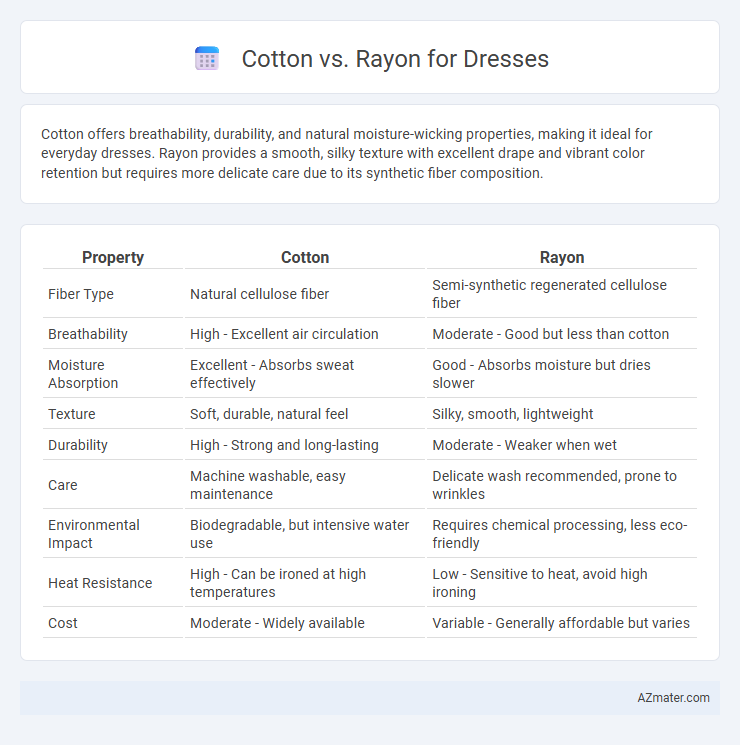Cotton offers breathability, durability, and natural moisture-wicking properties, making it ideal for everyday dresses. Rayon provides a smooth, silky texture with excellent drape and vibrant color retention but requires more delicate care due to its synthetic fiber composition.
Table of Comparison
| Property | Cotton | Rayon |
|---|---|---|
| Fiber Type | Natural cellulose fiber | Semi-synthetic regenerated cellulose fiber |
| Breathability | High - Excellent air circulation | Moderate - Good but less than cotton |
| Moisture Absorption | Excellent - Absorbs sweat effectively | Good - Absorbs moisture but dries slower |
| Texture | Soft, durable, natural feel | Silky, smooth, lightweight |
| Durability | High - Strong and long-lasting | Moderate - Weaker when wet |
| Care | Machine washable, easy maintenance | Delicate wash recommended, prone to wrinkles |
| Environmental Impact | Biodegradable, but intensive water use | Requires chemical processing, less eco-friendly |
| Heat Resistance | High - Can be ironed at high temperatures | Low - Sensitive to heat, avoid high ironing |
| Cost | Moderate - Widely available | Variable - Generally affordable but varies |
Introduction: Cotton vs Rayon for Dress Fabrics
Cotton and rayon are two popular dress fabrics distinguished by their fiber origin and fabric properties. Cotton, a natural fiber from the cotton plant, offers breathability, durability, and moisture absorption, making it ideal for everyday wear. Rayon, a semi-synthetic fiber derived from cellulose, mimics the softness and drape of natural silk while providing a lightweight and smooth texture, often chosen for formal and summer dresses.
Natural Origins: Cotton Explained
Cotton, derived from the natural fibers of the cotton plant, is prized for its breathability, softness, and hypoallergenic properties, making it ideal for dress fabrics. Its natural origins ensure sustainability and biodegradability, aligning with eco-conscious fashion trends. Unlike rayon, which is semi-synthetic and chemically processed, cotton maintains its purity as a wholly natural fiber, enhancing comfort and durability in clothing.
Synthetic Beginnings: Understanding Rayon
Rayon, a semi-synthetic fiber derived from regenerated cellulose, mimics the softness and breathability of natural cotton while offering enhanced drape and sheen ideal for dresses. Unlike cotton's pure natural origin, rayon undergoes chemical processing to transform wood pulp or bamboo into versatile fabric, providing a lightweight and smooth texture that complements dress designs. Understanding rayon's synthetic beginnings helps in appreciating its unique blend of natural feel and manufactured durability, distinguishing it from traditional cotton dresses.
Texture and Feel: Comfort Comparison
Cotton dresses offer a soft, breathable texture that feels natural and cozy against the skin, making them ideal for everyday wear and warm climates. Rayon, derived from cellulose fibers, provides a smooth, silky feel that drapes elegantly while maintaining a lightweight and cool comfort. Both fabrics prioritize comfort, but cotton excels in moisture absorption and durability, whereas rayon shines in softness and fluidity for dress designs.
Breathability and Moisture Absorption
Cotton excels in breathability and moisture absorption due to its natural fibers, allowing air to circulate freely and moisture to evaporate quickly, making it ideal for hot and humid climates. Rayon, while also breathable, tends to trap moisture longer because it is semi-synthetic, which can lead to a damp feeling during prolonged wear. Choosing cotton dresses offers superior comfort and dryness, especially for sensitive skin or active wear, whereas rayon provides a softer texture but may require more care to maintain breathability and moisture control.
Durability and Longevity
Cotton fabrics exhibit superior durability and longevity compared to rayon due to their natural fiber structure, which withstands frequent washing and abrasion without significant wear. Rayon, being a semi-synthetic fiber made from cellulose, tends to weaken when exposed to moisture and prolonged use, leading to faster deterioration and loss of texture. For dress materials, cotton's resilience makes it a preferred choice for long-lasting garments that maintain shape and comfort over time.
Maintenance and Care Differences
Cotton dresses offer durability and easy maintenance, requiring simple machine washing and minimal special care, while rayon dresses demand more delicate handling such as hand washing or dry cleaning to prevent shrinking and fabric damage. Cotton's natural fibers withstand frequent laundering and high temperatures, making it ideal for everyday wear, whereas rayon's semi-synthetic cellulose fibers are more prone to weakening when wet and can lose shape without proper care. Choosing cotton reduces long-term maintenance efforts and costs, while rayon requires attentive care to preserve its softness and drape.
Environmental Impact: Cotton vs Rayon
Cotton production requires significant water usage and extensive pesticide application, contributing to soil degradation and water pollution. Rayon, often derived from wood pulp, involves chemical-intensive processing with potential release of toxic substances, impacting air and water quality. Sustainable practices like organic cotton cultivation and closed-loop rayon manufacturing can reduce environmental harm associated with both fibers.
Pricing and Affordability
Cotton dresses generally offer better affordability due to widespread availability and lower production costs, making them a popular choice for budget-conscious consumers. Rayon, while often comparable in price to mid-range cotton, can be slightly more expensive due to its semi-synthetic manufacturing process and higher maintenance needs. Pricing for both fabrics fluctuates based on quality, brand, and retail markup, but cotton consistently remains the more economical option for everyday wear.
Best Uses: Choosing Cotton or Rayon for Dresses
Cotton dresses excel in breathability and durability, making them ideal for casual wear, hot climates, and everyday comfort. Rayon offers a silk-like texture with excellent drape, perfect for formal occasions and flowing summer dresses where softness and elegance are desired. Selecting cotton suits active lifestyles and warm weather, while rayon fits best for stylish, lightweight garments that require a smooth finish.

Infographic: Cotton vs Rayon for Dress
 azmater.com
azmater.com